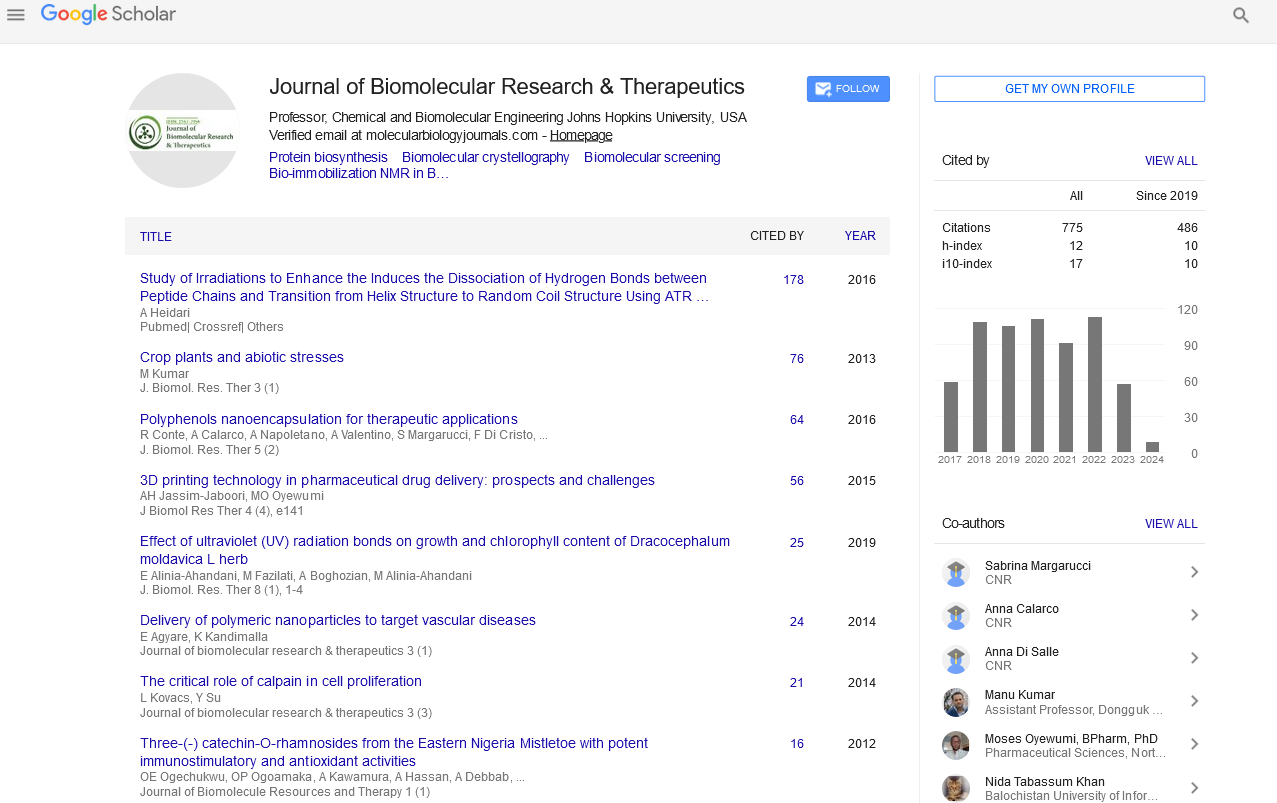PMC/PubMed Indexed Articles
Indexed In
- Open J Gate
- Genamics JournalSeek
- ResearchBible
- Electronic Journals Library
- RefSeek
- Hamdard University
- EBSCO A-Z
- OCLC- WorldCat
- SWB online catalog
- Virtual Library of Biology (vifabio)
- Publons
- Euro Pub
- Google Scholar
Useful Links
Share This Page
Journal Flyer

Open Access Journals
- Agri and Aquaculture
- Biochemistry
- Bioinformatics & Systems Biology
- Business & Management
- Chemistry
- Clinical Sciences
- Engineering
- Food & Nutrition
- General Science
- Genetics & Molecular Biology
- Immunology & Microbiology
- Medical Sciences
- Neuroscience & Psychology
- Nursing & Health Care
- Pharmaceutical Sciences
Perspective - (2021) Volume 10, Issue 8
Perspective on Melanogenesis
Juliee Katharine*Received: 18-Aug-2021 Published: 30-Aug-2021, DOI: 10.35248/2167-7956.21.10.171
Perspective
The event of hyperpigmentation or hypopigmentation after irritation is a typical condition in dermatology and cosmetology. Since the specific instrument of its event isn't yet known, anticipation and treatment are inconvenient. Past examinations have affirmed that α melanocyte animating chemical, foundational microorganism factor and different components can advance melanogenesis related quality articulation through the initiation of flagging pathways. Late examinations have uncovered that an assortment of provocative go between can likewise take an interest in the guideline of melanogenesis in melanocytes.
Further examinations have tracked down that these provocative components might enact or repress melanogenesis related flagging pathways, (for example, protein kinase An and mitogen actuated protein kinase) by restricting to comparing receptors, in this manner advancing or restraining the statement of melanogenesis related qualities and managing skin pigmentation measures. This recommends that the advancement of medications or treatment strategies according to the point of view of directing aggravation can give ground breaking thoughts and new focuses for the treatment of pigmented dermatosis. This survey diagrams the current comprehension of the aggravation components' parts in melanogenesis.
A coordination framework has been shaped under the connection of different cells in the skin. For example, the cutaneous neuroninsusceptible endocrine framework comprises of connection and coordination between keratinocytes, melanocytes and dendritic Langerhans cells in the epidermis and the parts of the dermis like pole cells, macrophages, fibroblasts and nerve cells. Allergens, microorganisms, synthetic improvements, and actual harm would all be able to prompt skin irritation, which is a guard reaction to exogenous or endogenous upgrades. Skin irritation assumes an essential part in the body, for example, opposing the attack of microorganisms and different microbes and advancing the maintenance of wounds. Late investigations have uncovered that fiery cytokines are firmly identified with skin pigmentation.
Skin hyperpigmentation or hypopigmentation after irritation is a clinically normal indication. Different intense or on-going provocative skin responses might cause changes in skin pigmentation like psoriasis, dermatitis, or laser medical procedure. On-going examinations have affirmed that interleukin and other incendiary arbiters can control the expansion and separation of human epidermal melanocytes straightforwardly or in a roundabout way and take part in the guideline of melanogenesis in melanocytes. Medicines that adjust these fiery go between may have incredible clinical utility in the treatment of some dyschromatosis. This audit will zero in on the job of fiery factors in melanogenesis and the components in question.
Cycle of melanogenesis
Melanocytes begin from the ectodermal neural peak, move to the mesenchyme as the undeveloped organism creates, and afterward further relocate to the skin, eye uveal, stria vascularis, vestibular organ, endolymphatic sac and pia mater. The movement, multiplication, and separation of melanoblasts are mostly directed by administrative components discharged by the dorsal neural cylinder, ectoderm, and keratinocytes, for example, the family of Wingless-type protein (WNT), endothelin 3 (EDN3), and undifferentiated cell factor (SCF). Melanogenesis in develop melanocytes happens in melanosomes. Melanosomes are remarkable organelles situated in the cytoplasm of melanocytes, which contain key chemicals directing the creation of shades, for example, tyrosinase (TYR), tyrosinase-related protein-1 (TYRP-1) and tyrosinase-related protein-2 (TYRP-2) . Initiation of the record factor microphthalmia-related record factor (MITF) brings about the up guideline of the declaration of key qualities, for example, TYR, TYRP-1 and TYRP-2, and advances melanogenesis in melanocytes. Develop melanosomes can relocate from the perinuclear district to the dendrites of melanocyte under the guideline of tubulin (kinesin, dynein). In the epidermis, melanocytes are related with 30 to 40 keratinocytes through dendrites, moving full grown melanosomes into the cytoplasm of keratinocytes.
Citation: Katharine J (2021) Perspective on Melanogenesis. J Biomol Res Ther. 10: 171.
Copyright: © 2021 Katharine J. This is an open-access article distributed under the terms of the Creative Commons Attribution License, which permits unrestricted use, distribution, and reproduction in any medium, provided the original author and source are credited.


